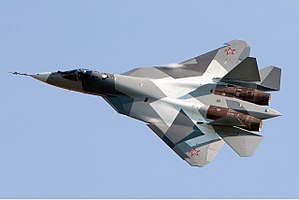Although most information about the PAK FA is classified, sources within in the Russian Air Force and Defense Ministry have openly stated that it features stealth technology and has the capability to supercruise,and incorporate advanced avionics such as an Active Electronically Scanned Array (AESA) radar and an artificial intelligence system. It is to be outfitted with the next generation of air-to-air, air-to-surface, and air-to-ship missiles.
Video from the PAK FA's first flight shows that it has no conventional rudders; its vertical tails are fully movable. This special tail fin design is mechanically similar to V-tails used by the Northrop YF-23 in 1990s, but is supplemented by dedicated horizontal stabilators (as on the F-22). The T-50 has wing leading-edge devices above the jet engine intakes that may pose a challenge for signature control.
Composites are used extensively on the T-50 and comprise 25% of its weight and almost 70% of the outer surface.It is estimated that titanium alloy content of the fuselage is 75%. Sukhoi's concern for minimizing radar cross-section (RCS) and drag is also shown by the provision of two tandem main weapons bays in the centre fuselage, between the engine nacelles. Each is estimated to be between 4.9-5.1 m long. The main bays are augmented by bulged, triangular-section bays at the wing root.
The Moskovsky Komsomolets reported that the T-50 has been designed to be more maneuverable than the F-22 Raptor, at the cost of making it less stealthy than the F-22. One of the design elements that have such an effect is the Leading Edge Vortex Controller (LEVCON).
Cockpit
Life support systems will enable pilots to sustain 9 g in maneuvers. New pressure suits will allow safe ejection at altitudes of up to 23 km.Stealth
Russian sources indicate the PAK FA lacks the very-low-observable (VLO) stealth of the F-22. Instead, reducing observability with composite materials, aerodynamic configuration, and engine signature reduction measures to achieve low (but not very-low) levels of radar, optic and infrared signatures.Carlo Kopp has said that once the PAK FA is fully developed into a stealthy design, it should be a rough match for the F-35 in low observability, but aerodynamically superior.Sources claim that the PAK FA may incorporate "Plasma stealth" although no solid evidence of this has been shown.Armament
The PAK FA has a reported maximum weapons load of 7,500 kg.It has an apparent provision for a cannon (most likely GSh-301), and could possibly carry two 30 mm cannons. The PAK FA has two internal bays estimated at 4.6-4.7 metres by 1-1.1 metres.The expected initial armaments include Kh-35UE (AS-20 "Kayak"), Kh-38ME, Kh-58UShKE (AS-11 "Kilter"), and RVV-MD (AA-11 "Archer") missiles.Two Izdeliye 810 Extended beyond visual range missiles per weapons bay. Multiple Izdeliye 180 / K77M beyond visual range missiles. K74 and K30 within visual range missiles can also be carried. Two KH38M or KH58 USHK air-to-ground missiles per weapons bay. Multiple 250–500 kg precision guided bombs per weapons bay, with a maximum of 10 bombs in internal bays. Other possible loads include one 1,500 kg bomb per weapons bay or two 400 km+ range anti-AWACS weapons (such as the RVV-BD) on external hardpoints.
PAK FA chief designer Alexander Davydenko has said that there is a possibility of the installation of BrahMos supersonic missile on the PAK FA and its FGFA derivative. However, it is unclear how these missiles will be installed, though it can be one or two missiles only due to heavy weight of the BrahMos

